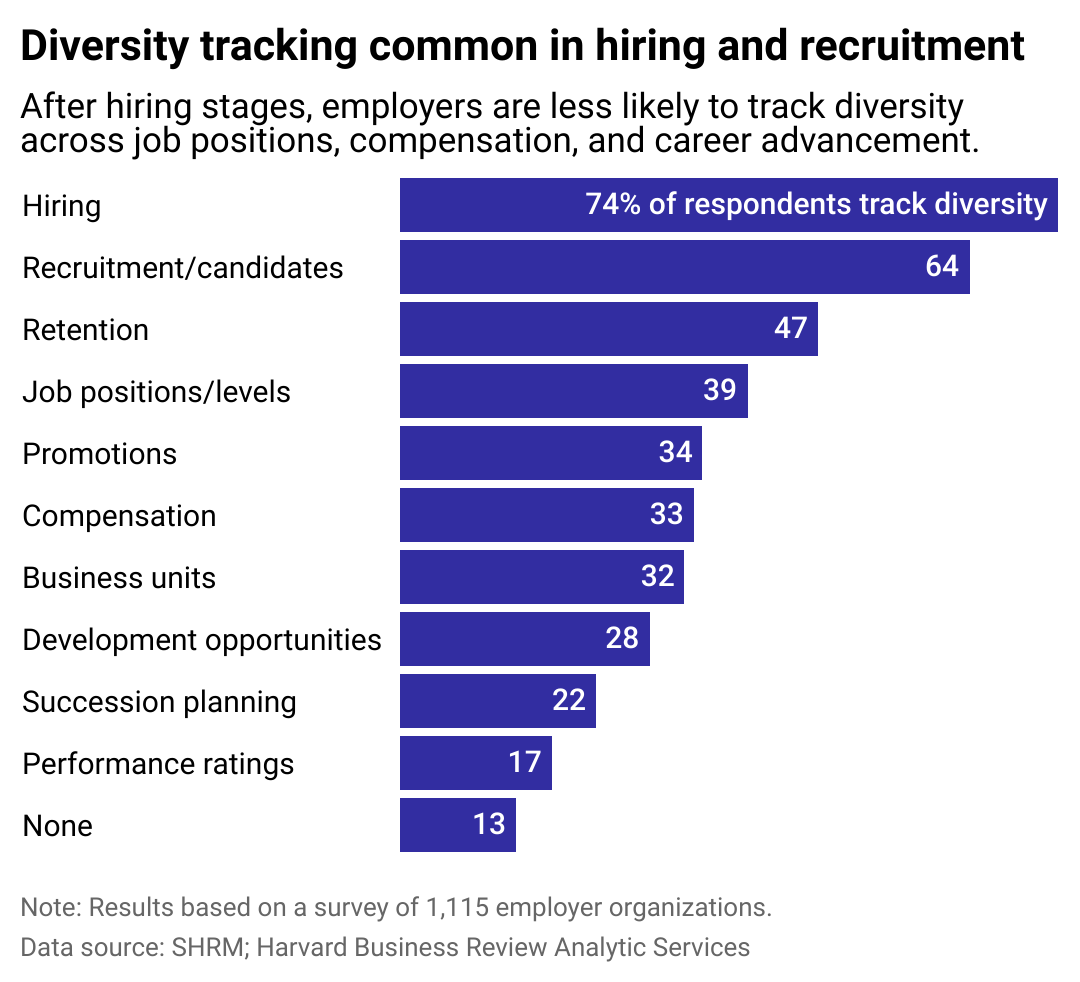
NONGASIMO // Shutterstock

Are most employers tracking diversity in hiring and recruitment?
Diversity initiatives date back to the 1960s, but 2020 sparked a wave that led employers to make very vocal pledges to improve diversity, equity, and inclusion inside their organizations. Executives at Walmart, Citigroup, Bank of America, Nike, PwC, Comcast, Johnson & Johnson, and dozens of others took to cable news shows to espouse the business benefits of building more diverse workforces and pledged billions to organizations fighting racial injustice.
Between 2019 and 2022, positions for chief diversity and inclusion officers rose almost 170%, according to a LinkedIn study. This growth has increased diversity tracking in hiring and recruitment.
Revelo identified the top business areas where employers track diversity, using data from a May 2021 report by the Society for Human Resource Management and the Harvard Business Review.
The report analyzed survey results gathered between April and May 2021 from over 1,100 organizational leaders in North America. Of those, 65% listed DEI as “a high strategic priority.”
Significant differences existed among the three categories of respondents: leaders (those who say their organization is successful in improving DEI), laggards (those who say their organization is unsuccessful), and followers (those who fall in the middle). Of the laggard respondents, 50% said a lack of committed leadership hindered their efforts to improve DEI, and 72% said senior-level lack of diversity holds them back from improving.
To effectively measure diversity in hiring and recruitment, it is crucial to establish a baseline regarding the company’s readiness and willingness to improve diversity. “If you don’t know where you started or where you are currently, how do you know if you’ve made any progress?” vice president of research for SHRM-SCP Trent Burner said.
Effective data is as specific as possible, acquiring figures that reflect more than just overall diversity. For example, a January 2023 article from the World Economic Forum states that in the U.S., 1 in 5 C-Suite leaders are white women, while just 4% are women of color.
One of the ways organizations are increasing diversity is through looking beyond their geographic region and hiring across states—and even countries. The rise in remote work has buoyed this practice.
Wharton School of the University of Virginia research found that jobs that changed from in-person to remote during the height of the COVID-19 pandemic led to 15% more female applicants and 33% more applicants from underrepresented racial and ethnic groups. The researchers list three key reasons for the boost in diversity recruitment: time flexibility, location flexibility, and limiting face-to-face interaction. The latter element can shield these employees from microaggressions and outright discrimination from biased and racist coworkers.
Another method for increasing diversity in the workplace is through training managers in hiring processes that promote diversity. The Harvard Business Review report found that 68% of leaders provided DEI training for managers, while just 38% of laggards did so. The percentages were almost identical for DEI training for all employees.
In 2020, Fortune 500 companies, representing the largest corporations by revenue, reached record levels of representation of women among chief executives at 37 companies. In 2023, women and people from underrepresented racial and ethnic groups held 1 in 5 board seats governing Fortune 500 companies. A Bloomberg analysis found during the year following the Black Lives Matter protests that S&P 100 companies added 300,000 more jobs, and 94% of those roles went to people of color.
However, implementing DEI practices shouldn’t end once the hiring process is over, according to the Society for Human Resource Management.
![]()

DE&I tracking limited beyond hiring practices
The survey results suggest that after hiring diverse candidates, companies are less likely to keep diversity data on other aspects of their business, such as promoting from within their organization or in succession planning for leadership roles.
This lack of data suggests that support is lacking, too.
Only 48% of leaders in the study reported tracking promotions, while just 16% of laggards reported doing so. The numbers were similar for accommodation and compensation, which remain vital measures for true growth. According to the Department of Labor, Black workers and women make 76 cents to the dollar compared to white workers and men, respectively.
Reports generally show companies still have a fair amount of progress to make. A Deloitte executive warned that despite diversity gains in recent years, it might be 2060 before top corporate boards are representative of the country’s population, citing a report published with the Alliance for Board Diversity on demographic shifts at the board level. Despite the need for continued change, corporations face significant diversity hiring and recruitment cutbacks.
In the last year, major tech companies, including Google—which vowed to bolster racial equity and inclusion in 2020—have made cuts to their DEI budgets as large as 90% in some cases, ceased internal educational efforts, and laid off DEI-focused staff members.
Recent surveys of corporate leadership also indicate that satisfaction internally with their companies’ DEI practices has been slipping. In 2023, 18% fewer leaders endorsed the effectiveness of their own companies’ efforts to improve DEI than two years prior, according to a survey of more than 15,000 professionals by leadership development firm DDI.
Research has shown, however, that increased diversity in the workplace isn’t just a moral ideal but is just plain good for business. Sources such as the World Economic Forum demonstrate that more diverse companies are more innovative than those with below-average diversity.
Global consulting firm McKinsey showed in a 2019 study that companies with gender diversity in the top quartile for executive teams were at least 25% more likely to see better financial returns than those in the bottom quartile. Similarly, companies in the top quartile for racial and ethnic diversity outperformed those in the bottom quartile by 36%.
Additional writing and story editing by Shannon Luders-Manuel. Copy editing by Kristen Wegrzyn.
This story originally appeared on Revelo and was produced and
distributed in partnership with Stacker Studio.